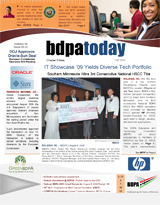|
|
|
bdpatoday
Volume 31 | 10.12.09 | Columbus Day |
|
|
|
|
|
bdpatoday blogs, discussions, and
event calendars are enhanced by

2009 Annual Awards Banquet | NOV 12
Reserve tables or tickets today. RSVP on or before October 31.
bdpatoday | online
Missed one? In case we missed you yesterday, our newsletter archives and Acronym of the Day are updated each week for new sponsors, BDPA chapter interest groups (CIGs) and new BDPA members up to the last 100 online editions. Discover more...
What if Christopher Columbus used GPS systems?
Professor Tom Herring spends his research hours mapping Earth with GPS satellite technology. But for Columbus Day, Herring sets aside modern technology to tell how he makes his students learn to chart their courses the hard way-using the sun to determine latitude, and other centuries-old tricks of the trade.
bdpatoday-- In a 2008 Popular Mechanics (PM) article, Tom Herring is featured showing his students how to use modern GPS systems not just for finding direction but also for conducting scientific research, while teaching the Modern Navigation course at the Massachusetts Institute of Technology (MIT.) To make accurate maps of areas with lots of seismic activity, such as California's San Andreas fault, Herring uses laser altimetry: Satellites can fire lasers to specific points on Earth and measure how long it takes for the light to bounce back. A satellite fires thousands of beams per second in order to map terrain. But before Herring's students get to play with fancy technology, Herring makes them learn how to navigate the old-fashioned way-with the same techniques that Christopher Columbus used 516 years ago on his first voyage across the ocean blue.
Five centuries ago, sailors depended mostly on taking latitude readings to get where they were going. So Herring starts his students out with a sextant, an instrument used to divine one's latitude by using the position of the sun at high noon. To determine their distance from the equator, sailors used the ship's celestial charts to check the sun's height in the sky against the date.
But compared to Columbus' crew, Herring's students have plenty of advantages. Select here to read more...
|


GPS
The GPS (Global Positioning System) is a "constellation" of 24 well-spaced satellites that orbit the Earth and make it possible for people with ground receivers to pinpoint their geographic location. The location accuracy is anywhere from 100 to 10 meters for most equipment. Accuracy can be pinpointed to within one (1) meter with special military-approved equipment. GPS equipment is widely used in science and has now become sufficiently low-cost so that almost anyone can own a GPS receiver.
The GPS is owned and operated by the U.S. Department of Defense but is available for general use around the world. Briefly, here's how it works:
- 21 GPS satellites and three spare satellites are in orbit at 10,600 miles above the Earth. The satellites are spaced so that from any point on Earth, four satellites will be above the horizon.
- Each satellite contains a computer, an atomic clock, and a radio. With an understanding of its own orbit and the clock, it continually broadcasts its changing position and time. (Once a day, each satellite checks its own sense of time and position with a ground station and makes any minor correction.)
- On the ground, any GPS receiver contains a computer that "triangulates" its own position by getting bearings from three of the four satellites. The result is provided in the form of a geographic position - longitude and latitude - to, for most receivers, within 100 meters.
- If the receiver is also equipped with a display screen that shows a map, the position can be shown on the map.
- If a fourth satellite can be received, the receiver/computer can figure out the altitude as well as the geographic position.
- If you are moving, your receiver may also be able to calculate your speed and direction of travel and give you estimated times of arrival to specified destinations.
The GPS is being used in science to provide data that has never been available before in the quantity and degree of accuracy that the GPS makes possible. Scientists are using the GPS to measure the movement of the arctic ice sheets, the Earth's tectonic plates, and volcanic activity. GPS receivers are becoming consumer products. In addition to their outdoor use (hiking, cross-country skiing, ballooning, flying, and sailing), receivers can be used in cars to relate the driver's location with traffic and weather information.
______________________
Source:
Tech Target
|
|
|
|
|
|
|
|
|
2009 Annual Scholarship & Awards Banquet
November 12, 6-9 PM
Washington Navy Yard
Conference Center
Keynote: Cynthia Miller
|
NROTC Scholarships
now on deck @ BDPA!
Cover story in bdpatoday
|
FALL 2009 Print Edition
Download versions available 
|
|
|
|
|
|
About BDPA-DC
NBDPA's Washington, D.C. Chapter was founded in 1978 by Norman Mays. It was incorporated in 1981 as a domestic not-for-profit corporation in the District of Columbia. In February of 1988, Black Data Processing Associates of Washington, D.C. Metropolitan Area (BDPA-DC) became an IRS Section 501(c)(3) Public Charity. Today, BDPA-DC provides professional development services for its members and stakeholders in direct support of local and regional STEM (Science. Technology. Engineering. Math) initiatives. Towards this end, BDPA-DC partners with BDPA Baltimore, BDPA Northern Virginia, and BDPA Richmond to support members and stakeholders within the National Capital Region (NCR) and the Baltimore-Richmond Corridor. BDPA-DC also serves NBDPA, BDPA Chapters and Chapter Interest Groups (CIGs) as a federal news bureau, government relations liaison, and bdpatoday newsletter clearinghouse for emerging NBDPA Chapters.
BDPA-DC
611 Pennsylvania Avenue, S.E., Suite 213
Washington, District of Columbia 20003, USA
|
| Select here to join, sign-up a co-worker, or renew memberships | |
|
bdpatoday ISSN 1946-1429 is published by BDPA-DC and participating NBDPA Chapters.
| |
|